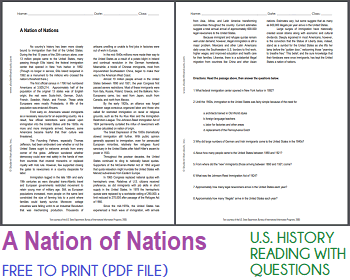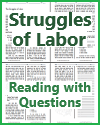A Nation of Nations |
No country's history has been more closely bound to immigration than that of the United States. During the first 15 years of the 20th century alone, over 13 million people came to the United States, many passing through Ellis Island, the federal immigration center that opened in New York harbor in 1892. (Though no longer in service, Ellis Island reopened in 1992 as a monument to the millions who crossed the nation's threshold there.)  The first official census in 1790 had numbered Americans at 3,929,214. Approximately half of the population of the original 13 states was of English origin; the rest were Scots-Irish, German, Dutch, French, Swedish, Welsh, and Finnish. These white Europeans were mostly Protestants. A fifth of the population was enslaved Africans. The first official census in 1790 had numbered Americans at 3,929,214. Approximately half of the population of the original 13 states was of English origin; the rest were Scots-Irish, German, Dutch, French, Swedish, Welsh, and Finnish. These white Europeans were mostly Protestants. A fifth of the population was enslaved Africans.From early on, Americans viewed immigrants as a necessary resource for an expanding country. As a result, few official restrictions were placed upon immigration into the United States until the 1920s. As more and more immigrants arrived, however, some Americans became fearful that their culture was threatened. The Founding Fathers, especially Thomas Jefferson, had been ambivalent over whether or not the United States ought to welcome arrivals from every corner of the globe. Jefferson wondered whether democracy could ever rest safely in the hands of men from countries that revered monarchs or replaced royalty with mob rule. However, few supported closing the gates to newcomers in a country desperate for labor. Immigration lagged in the late 18th and early 19th centuries as wars disrupted trans-Atlantic travel and European governments restricted movement to retain young men of military age. Still, as European populations increased, more people on the same land constricted the size of farming lots to a point where families could barely survive. Moreover, cottage industries were falling victim to an Industrial Revolution that was mechanizing production. Thousands of artisans unwilling or unable to find jobs in factories were out of work in Europe. In the mid-1840s millions more made their way to the United States as a result of a potato blight in Ireland and continual revolution in the German homelands. Meanwhile, a trickle of Chinese immigrants, most from impoverished Southeastern China, began to make their way to the American West Coast. Almost 19 million people arrived in the United States between 1890 and 1921, the year Congress first passed severe restrictions. Most of these immigrants were from Italy, Russia, Poland, Greece, and the Balkans. Non-Europeans came, too: east from Japan, south from Canada, and north from Mexico. By the early 1920s, an alliance was forged between wage-conscious organized labor and those who called for restricted immigration on racial or religious grounds, such as the Ku Klux Klan and the Immigration Restriction League. The Johnson-Reed Immigration Act of 1924 permanently curtailed the influx of newcomers with quotas calculated on nation of origin. The Great Depression of the 1930s dramatically slowed immigration still further. With public opinion generally opposed to immigration, even for persecuted European minorities, relatively few refugees found sanctuary in the United States after Adolf Hitler's ascent to power in 1933. Throughout the postwar decades, the United States continued to cling to nationally based quotas. Supporters of the McCarran-Walter Act of 1952 argued that quota relaxation might inundate the United States with Marxist subversives from Eastern Europe. In 1965 Congress replaced national quotas with hemispheric ones. Relatives of U.S. citizens received preference, as did immigrants with job skills in short supply in the United States. In 1978 the hemispheric quotas were replaced by a worldwide ceiling of 290,000, a limit reduced to 270,000 after passage of the Refugee Act of 1980. Since the mid-1970s, the United States has experienced a fresh wave of immigration, with arrivals from Asia, Africa, and Latin America transforming communities throughout the country. Current estimates suggest a total annual arrival of approximately 600,000 legal newcomers to the United States. Because immigrant and refugee quotas remain well under demand, however, illegal immigration is still a major problem. Mexicans and other Latin Americans daily cross the Southwestern U.S. borders to find work, higher wages, and improved education and health care for their families. Likewise, there is a substantial illegal migration from countries like China and other Asian nations. Estimates vary, but some suggest that as many as 600,000 illegals per year arrive in the United States. Large surges of immigration have historically created social strains along with economic and cultural dividends. Deeply ingrained in most Americans, however, is the conviction that the Statue of Liberty does, indeed, stand as a symbol for the United States as she lifts her lamp before the "golden door," welcoming those "yearning to breathe free." This belief, and the sure knowledge that their forebears were once immigrants, has kept the United States a nation of nations. |
Directions: Read the text above, then answer the
questions below. |
| 1. What federal immigration center opened in New York harbor in 1892? 2. Until the 1900s, immigration to the United States was fairly simple because of the need for a. architects trained in Old World styles b. foreign language teachers c. labor for factories and other areas d. replacement of the Pennsylvania Dutch 3. Why did large numbers of German and Irish immigrants come to the United States in the 1840s? 4. About how many people came to the United States between 1890 and 1921? 5. From where did the "new" immigrants (those arriving between 1890 and 1921) come? 6. What was the Johnson-Reed Immigration Act of 1924? 7. Approximately how many legal newcomers arrive in the United States each year? 8. Approximately how many "illegals" arrive in the United States each year? Click here to print. |
 |
|---|
Text courtesy of the U.S. State Department,
Bureau of International Information Programs, 2005 |










